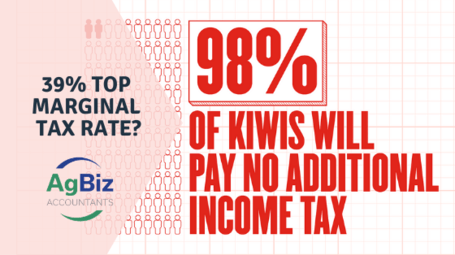The Labour Party has announced that if re-elected, they would introduce a new marginal tax rate of 39% for an individual’s income over $180,000. The 39% tax rate would only apply to income over $180,000 and the remainder of an individual’s income will be taxed at current marginal tax rates.
Labour believes this change will only affect 2% of the population (who earn more than $180,000) and explain that it will help maintain balance as they continue to manage the impact of Covid-19.
How will this new tax affect me?
If you currently earn more than $180k per year, this increase is likely to affect you.
In some circumstances, it may also affect you if you own shares or rental properties in your personal capacity (as seen in example 2 and 3 below).
Business income over $180k – before and after – example 1
John is a business owner earning $250,000 per year. Currently, he pays $73,420 of tax each year. If Labour’s tax proposal goes ahead, he will pay $77,620, an increase of $4,200 per year.
Bright line property sale – example 2
Aaron is a full-time employee who earns $130,000 pa. A year ago, he purchased a rental property for $450,000 and now he decides to sell it for $700,000 due to the hot property market. This results in a taxable bright line gain of $250,000.
Therefore, his total tax income for the year is $380,000 and his income over $180,000 would be taxed at 39% (tax on the $250,000 bright line gain would be $94,500 - $50,000 at 33% and $200,000 at 39%).
If the rental property was owned by a company the bright line would have been taxed at 28% (or $70,000 tax to pay) and if owned by a trust the tax rate would have been 33% ($82,500). Note: there are many other factors to consider with these decisions, not only tax.
Owning shares in a company and receiving dividends – example 3
Business owners are paid in different ways. Some take drawings, receive a PAYE salary, receive a shareholder salary, and others may receive dividends. There is no one size fits all to remuneration and different methods each have their own advantages and disadvantages.
In some situations, a company will pay the shareholders a shareholder salary (which is taxable income in their personal names), and the balance of the company profits is retained in the company and taxed at the company tax rate of 28%.
Although this appears to ‘save tax’ with the company tax rate at 28%, when a company pays a dividend (to clear the historical retained earnings in the company), the company pays another 5% tax to IRD. Therefore, in fact, the company pays 33% tax, however the final 5% tax is paid at a different time from when the actual income is earned.
We have outlined further information about this here, ‘The myth of the 28% company tax rate’.
When the company pays a dividend to the shareholder, the shareholder receives a tax credit of 33% being the tax that the company has already paid. This prevents the shareholder being taxed twice (once when the company earns the income and pays it to IRD, the second when the shareholder receives that income).
Up until now, the 33% tax, attached to companies’ dividends has aligned with the individuals marginal tax rate. Therefore, in most situations the shareholder does not have any further tax to pay on dividends received.
But, if the top marginal tax rate increases to 39% for income over $180,000, a shareholder may have a further 6% tax to pay on dividends received.
For example, Thomas receives a shareholder salary of $180,000 from the company, he pays tax of $50,320. Currently, any dividends he receives from the company already have 33% tax credits attached so there is not further tax to pay.
If Labour’s new tax goes ahead and Thomas receives a $100k dividend, he would have a further $6,000 of tax to pay (being the difference between 33% and 39% tax rates).
What can you do about this?
Consider the ownership structure of your business or rental properties :
- Trust’s pay tax at 33%,
- Companies pay tax at 28% (and a further 5% when dividends are paid)
- Is your portfolio and activity joint with a partner (who may have a lower marginal tax rate)?
- Who are the shareholders of your company and what are their tax rates?
- Does the current ownership structure meet your needs (not only from a tax perspective – risk, succession, industry, investment & capital contribution etc)?
Consider clearing out any company retained earnings if the top tax rate changes
- This may result in 5% DWT being paid now (which would be payable in future regardless) but may save a further 6% tax in the future (the difference between 33% and 39%).
Important notes
As with any transfer of property (shares, business, or real estate), a strong commercial reason is required for doing so - transfers for tax purposes alone suggest a tax avoidance arrangement.
There have been many tax avoidance court cases (especially pre-2009 when the top marginal tax rate was 39% and the trust tax rate was 33%). See Penny and Hooper case for more details.
There is a new trust Act commencing from January 2021. This will affect all trusts and result in higher compliance and administration costs, and a higher level of trustee involvement is required than previously (for example, keeping core trust documents, trust minutes etc.). We have outlined further information about the new trust Act here.
Losses in trust and companies are not able to be deducted against employment income; compared to an individual’s own name which if they paid PAYE tax will normally give rise to a tax refund.
A transfer or property (shares, business, or real estate) from you to another entity (such as a company or trust) will result in a sale in your own name (at market value). This may trigger a realised gain (a taxable event) which needs to be considered along with other commercial reasons. For example, depreciation recovery on buildings, gain on sale of livestock, or for a company: implication on losses or imputation credits carried forward.
We strongly recommend that any restructuring decisions are discussed with us.
Contact Us
Contact Tim Doyle or Jane Evans today to discuss your business continuity planning needs on 07 823 4980 or contact us. Our office is in Cambridge, NZ, but distance is no problem. We have many international and national clients.
This material has been prepared for informational purposes only, and is not intended to provide, and should not be relied on for, tax, legal or accounting advice. You should consult your own tax, legal and accounting advisors before engaging in any transaction.



